El Cid, Rodrigo Díaz de Vivar
The Reconquest of Spain from the Moslem occupation suffered several setbacks and reversals. But in the darkest hours, a selfless hero always arose to stem an impending onslaught. Such a danger threatened the Spanish Christians late in the eleventh century when a fanatical horde of North African Berbers invaded the peninsula. An overwhelming disaster was averted when Rodrigo Diaz de Vivar, known as “El Cid” (the lord, chief), resisted the whole might of Islam….
El Cid’s early years
When the noble father of the teenaged Rodrigo died around 1058, the future champion went to the Court of Prince Sancho where he studied law and excelled in all the knightly exercises. He earned his reputation as a mighty warrior in 1063 when a dispute arose with Navarre over the ownership of a recently reclaimed castle. Both sides agreed to settle it by single combat. The twenty-year-old Castilian subdued the champion of Navarre by the sword and was thereafter acclaimed “Campeador,” the “Conqueror.”
Sancho II of León and Castile
Sancho strongly disapproved of the partition of the kingdom at his father’s death and promptly challenged Alfonso to a battle for control of their inheritance. In two engagements, Rodrigo del Vivar led the Castilian army and his King Sancho to victory.
Doña Urraca of Zamora
Alfonso, stripped of his kingdom, went into exile with the Moslem king of Toledo. The two brothers had already connived to dispossess Garcia of his share earlier.
Urraca, a sister of the competing brothers and a strong supporter of Alfonso, entered into the family dispute, and through her influence Sancho was treacherously assassinated. The new King, now styled Alfonso VI, was suspected of complicity because of his close relationship to Urraca. Rodrigo, as Sancho’s champion and the leader of the Castilian nobility, exercised his legal right to force Alfonso to swear an oath of total innocence. Realizing that if he refused he would no longer be King, Alfonso complied. El Cid administered the oath and, on so doing, certainly jeopardized his future relationship with the King.
After the oath of purgation, the Cid then swore allegiance to Alfonso as his liege lord, a loyalty that Rodrigo faithfully observed for the rest of his life despite unjust and abusive treatment. During Sancho’s reign, he had held the highest rank in the kingdom. Now, distrusted by the King and extremely disliked by the King’s Leonese favorites, Rodrigo served his King in near obscurity for the next seven years.
El Cid forcing King Alfonso VI of León to swear in the Church of Santa Gadea de Burgos. Painting by Armando Menocal in 1889.
The animosity between the faithful Rodrigo and his envious enemies reached a climax a few years later. While the Cid was occupied handling legal matters, the principal military honors of the kingdom went to the worthless Count Garcia Ordonez, whose ambition, Ramon Menendez Pidal points out, “was only exceeded by his ineptitude.” Late in 1079 the King sent the Cid to Seville to collect tribute from the Moslem King, who was in arrears. At that moment, for some unexplained reason, Ordonez and four Castilian noblemen at the head of a large Moorish army from Granada led a destructive raiding expedition against Seville. El Cid, with only the small escort that accompanied him, rushed to repel the invaders. In a bitterly contested battle, the army of Granada suffered heavy losses and fled, leaving Ordonez and the King’s vassals in the Cid’s power. After three days the great warrior released the prisoners but kept their tents and weapons as spoils of war.
This event increased the hatred and envy of the King’s favorites toward Rodrigo, which infected the attitude of Alfonso himself, so much so that when the latter began the great work of his reign, the conquest of Toledo, the Cid was left ignored in his castle lest, as some have observed, he receive too much glory. Nevertheless, in retaliation for a daring Moslem raid, the indomitable soldier led his followers into the kingdom of Toledo on his own initiative with his usual triumphant success, capturing 7,000 prisoners and much booty. The irritated King, agitated once again by his inner circle, lost all objectivity, stripped the Cid of his rank and lands, and banished him from the kingdom.
Exile
Monasterio de San Pedro de Cardena in Burgos. This is where El Cid and his family lived after being exiled by Alfonso VI.
Three hundred of Castile’s best knights followed El Cid into exile. Faced with the necessity of providing an income for his vassals, Rodrigo assumed the responsibility of protecting Mutamin, the Moslem King of Saragossa, principally against the king’s brother, al-Hajib, King of Lerida. The situation was further complicated, however, when the King of Aragon and Berenguer, Count of Barcelona, allied themselves against Mutamin in their lust for spoils. Despite the attacks of so many adventurers, the Cid maintained his protectorate and won several spectacular victories against overwhelming odds in difficult circumstances.
Ramón Berenguer II, Count of Barcelona. Painted by Filippo_Ariosto
The lure of the wealth of Saragossa proved too much for Alfonso VI, so early in 1085 he invested the coveted city. Rodrigo, ever the Christian knight with a principled conscience, refused to fight against his King and withdrew once again into obscurity.
Success and failure of Alfonso VI
Alfonso now left the siege of Saragossa to others and returned to Toledo to begin the most illustrious part of his career, which greatly advanced the cause of the Reconquest. For four years he had been tightening a siege around the ancient capital of the old Visigoth Kingdom, choking off all possible assistance. Finally the Moslems capitulated and on May 25, 1085, Alfonso triumphantly entered Toledo. Strategically, the Christians had captured a salient fortress that extended their boundary line from the Douro River to the Tagus.
Statue of Alfonso VI of Castile in Toledo, Castile-La Mancha, Spain
With its capture, the Andalusian Moors could easily see their ultimate defeat. Al-Mutamid, the King of Seville, decided that no options remained except to seek help from the Berber emir Yusuf ibn Tashefin and the fierce Almoravids from the North African desert. When al-Mutamid’s son observed that the Almoravids could be just as predatory as the Christians, he replied, “I would rather be a camel driver in Africa than a swineherd in Castile.”
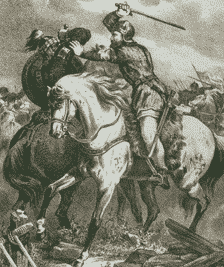 Yusuf landed in Spain with a sizable army and collected reinforcements as he marched northward. Alfonso lifted his siege at Saragossa and with Aragonese and French contingents intercepted the Moors five miles outside Badajoz at Sagrajas (Zallaka). The swift Berber horsemen utterly routed the Christians, who lacked maneuverability and discipline. Alfonso barely escaped with his life.
Yusuf landed in Spain with a sizable army and collected reinforcements as he marched northward. Alfonso lifted his siege at Saragossa and with Aragonese and French contingents intercepted the Moors five miles outside Badajoz at Sagrajas (Zallaka). The swift Berber horsemen utterly routed the Christians, who lacked maneuverability and discipline. Alfonso barely escaped with his life.
Rodrigo Diaz de Vivar, El Cid
Rival of the Holy War
The success of the uncompromising Almoravids that revived the Holy War led to a reconciliation between Alfonso and the Cid. Rodrigo returned to the East and sent his knights raiding in all directions. Seeing the destruction of their crops and livestock, several Moslem kingdoms, including the great stronghold of Valencia, hastened to pay tribute and submit to the relentless Castilian. In 1088 Alfonso once again gave in to his irrational rage and the court intrigue of his worthless favorites and drove from his realm the only commander capable of restraining the new Moslem power.
El Cid
Backed by the conservative jurists or doctors of the law, Yusuf installed a new spirit of fanaticism and resistance in al-Andalus. One by one he deposed the soft, easy-living Moslem kings whose palaces had become centers of pleasure and stifled spirituality. They appealed to Alfonso, who had also been attracted to the sensual side of life. In each case, the debauched King went down in defeat before the better-trained and organized Moslem cavalry.
El Cid holds the East
When El Cid returned to the East, he found himself completely abandoned and surrounded by enemies. The eastern Moors knew that Alfonso had renounced his powerful vassal and anticipated help from the advancing Almoravids.
During his darkest moment, the vaunted courage of the Cid did not fail him and he determinedly set about reconquering the rich territories he had once before subdued. He declared war against his old enemy al-Hajib, the King of Lerida. Raiding and ravaging, he laid the entire territory to waste. As before, al-Hajib called on Berenguer, the Count of Barcelona, to come to his assistance, and the latter assembled a large army of Catalan horsemen to drive out the Castilian.
The Cid took up his position in a rocky ravine that opened up into a narrow-necked valley. There his greatly out-numbered knights would be less vulnerable. Early in the morning, Berenguer attacked through the valley with all expectation of a resounding victory. The Cid rushed out from behind the rocks. In one ferocious charge, he attacked the main column with Berenguer in the lead and sent the Catalans into wild disorder. When the dust cleared, it became apparent that the Cid had won a great victory and had captured Berenguer with 5,000 of his knights, whom he held for ransom. Those who could paid. In a spirit of chivalry, the Cid released the rest from their burdens.
Doña Jimena Díaz, wife of El Cid
The Count formally renounced all claims to the lands of al-Hajib and handed them over to the protection of the Cid. Rodrigo, utilizing his reputation of invincibility, formed a vast protectorate in eastern and southeastern Spain that included Saragossa and Valencia, but he was to have the greatest difficulty in maintaining it. In all the cities and towns, an inflexible Moslem faction developed under Almoravid influence and awaited an opportunity to rebel against Christian suzerainty.
While Rodrigo was away solidifying his hold on Saragossa, he received bad news. The Almoravid faction in Valencia had murdered the compliant Moslem King and gained control of the city. Moreover, a large force under ibn Ayesha, Yusuf’s son, had already conquered Murcia and was advancing toward Valencia, having accepted the surrender of the smaller towns of Denia, Jativa, and Alcira.
An engraving by Alphonse-Marie-Adolphe de Neuville of El Cid ordering the execution of Ahmed, King of Valencia.
El Cid captures Valencia
Late in 1092, El Cid began the campaign to retake the city by raiding the Valencian countryside. Once he had captured the suburbs outside the walls, he applied a stranglehold around the city. Strangely, the Almoravid army of ibn Ayesha watched as if paralyzed by fear as Rodrigo consolidated his control over the entire area, even regaining the surrendered castles. Finally, Valencia, reduced to starvation, capitulated in June, 1094. This time the Cid Campeador occupied the key defensive positions inside the walls and indicated that his tolerance for peaceful coexistence had ended.
This one stunning defeat spurred Yusuf to make a more determined effort and avenge the severe blemish on his otherwise perfect military record. Over a hundred thousand African and Andalusian Moors, riding to the demoralizing sound of their drums, encircled the great walled city of Valencia and began to shower arrows on the houses and tents of the defending Christians, who numbered only a few thousand. The dauntless Cid encouraged his soldiers to resist and pray, but he could see that the usual tactics of hiding behind the walls would ensure eventual defeat.
Almoravid drummer used in great number's to demoralize the enemy.
After ten days, the Moors amassed a great force and moved against a main gate. Suddenly the gate burst open. The Cid and his Christian knights charged out, surprising the Moslems by their frightening boldness and speed. With a violent clash, they smashed into the center of the Mohammedan ranks and drove them back. The superior discipline and armament of the Cid’s troops gave him an advantage which broke down the cohesiveness of the Moors. When they turned to flee, the Christians fell upon them, inflicting terrible losses. When the Cid returned to his family, they could understand the ferocity of the struggle. The enemy’s blood covered his entire sword and had run up his arm to the elbow.
Painting by Eugène Delacroix at the Musée du Louvre
A few more victories remained for the Christian champion before he died in 1099. Much of the territory controlled by the Cid would revert back to the Moslems for a short period, but the great warrior had broken the force of the Almoravid invasion and allowed the knights of Aragon to build up their strength. Two younger brothers, successive kings of Aragon who had ridden with the Cid, Pedro I and Alfonso the Battler, led the fight in the next century. In the West, El Cid’s great-great-grandson, the Castilian King Alfonso VIII, won the definitive victory over the Mohammedans at Las Navas de Tolosa in 1212, and his grandson, Saint Ferdinand III drove all the Moors save those in the mountains of Grenada back to Africa. In the advance of Christianity, few have left such a legacy.
Signature of Rodrigo Díaz, also called El Cid, in a document by him in which he made a donation to the Cathedral of Valencia.
Jeremias Wells, History of Western Civilization (n.p., n.d), pp. 210-214.
Short Sto

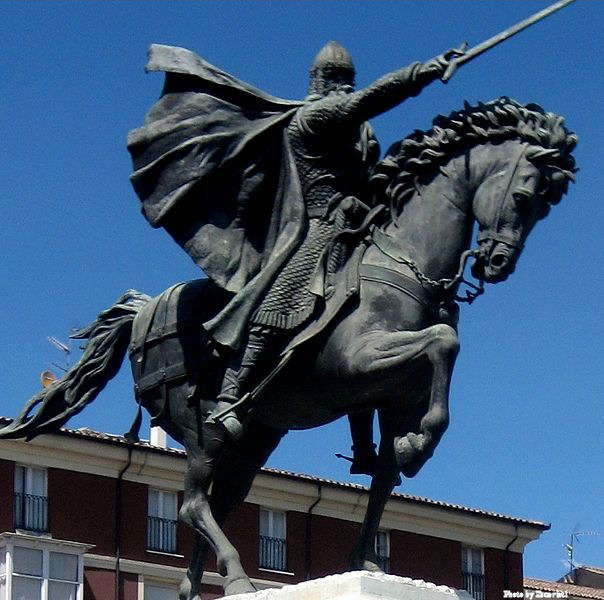
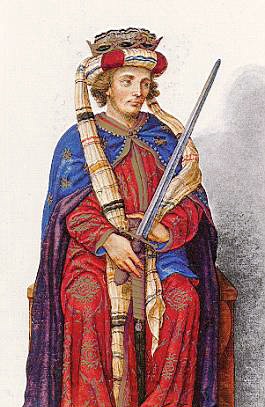
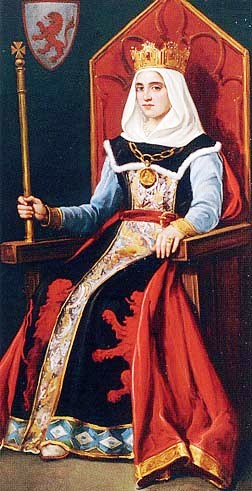
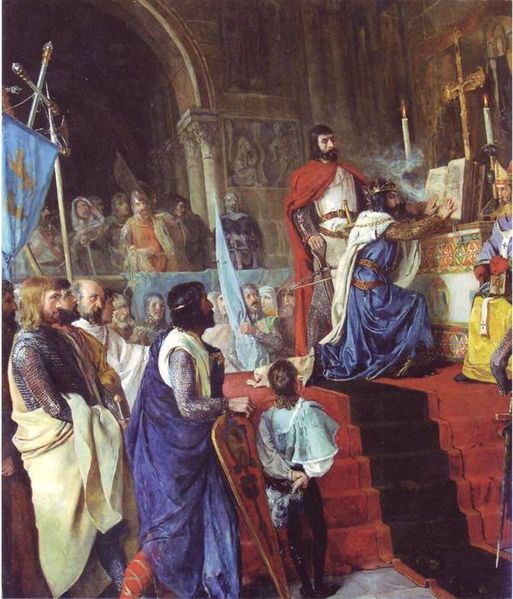
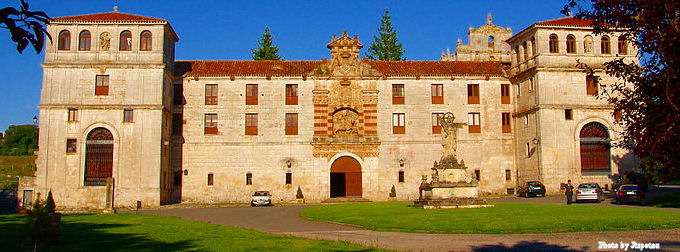

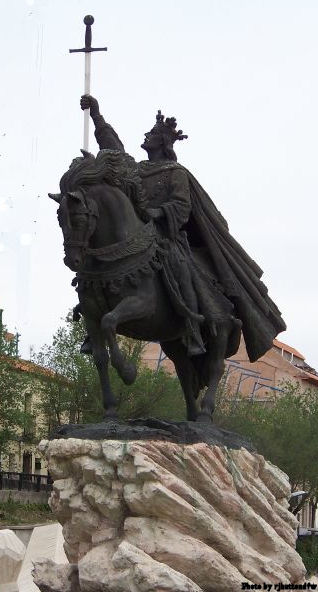
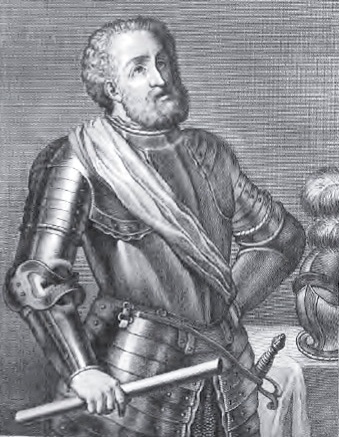
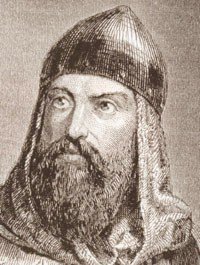
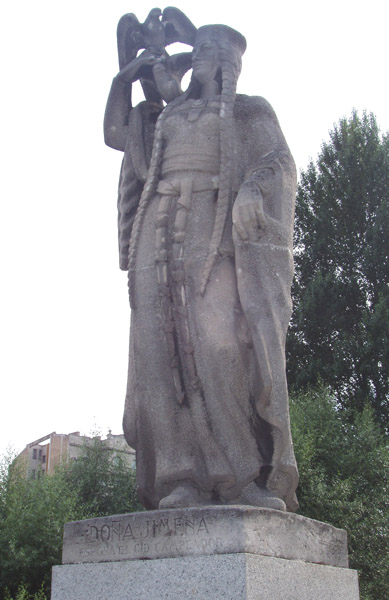
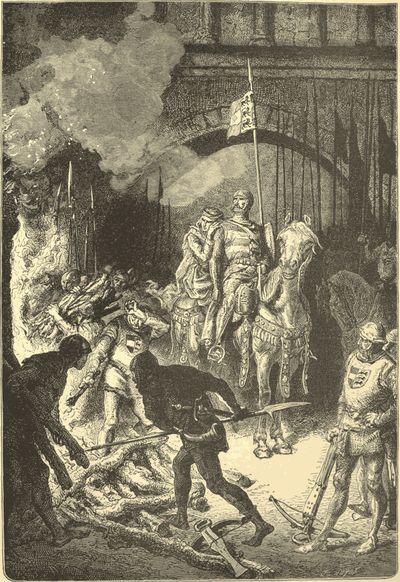
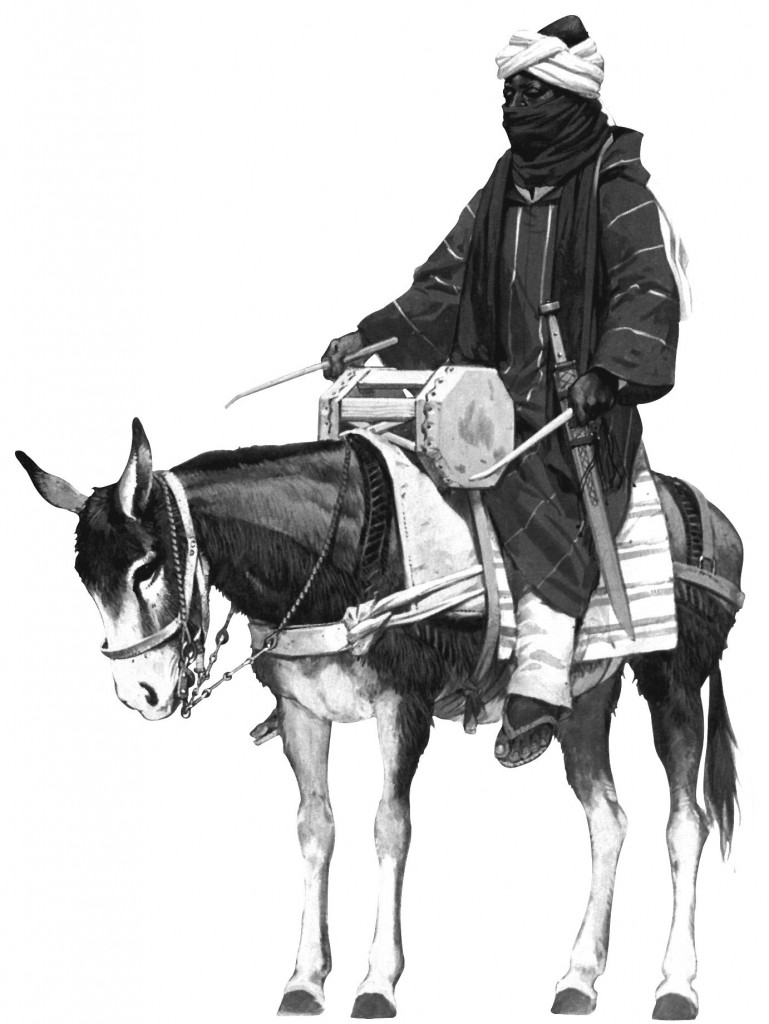
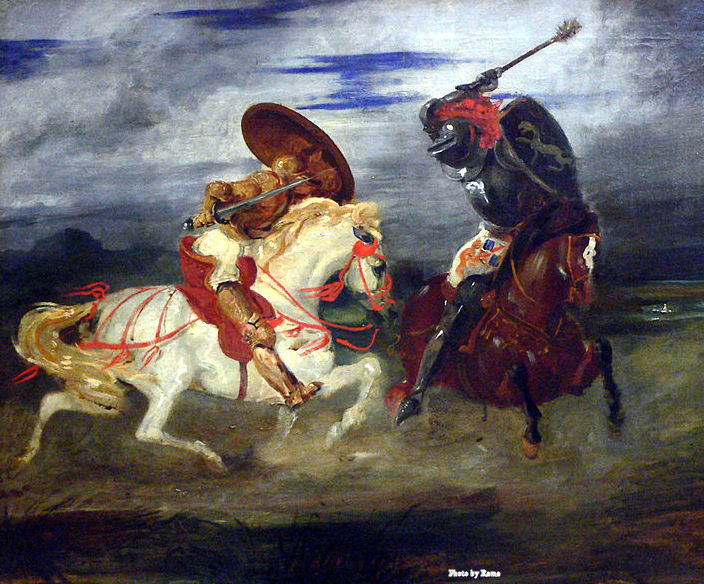

No comments:
Post a Comment